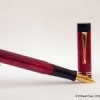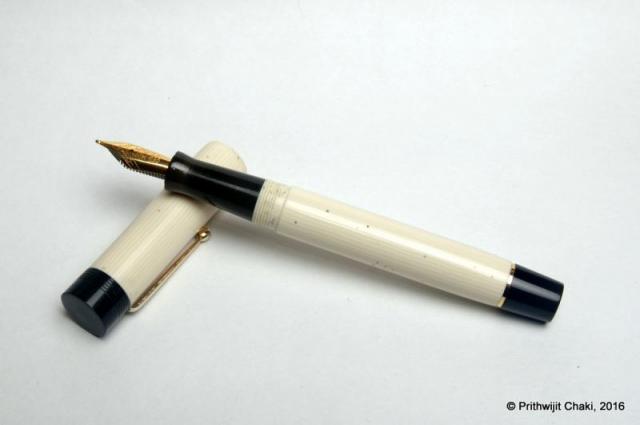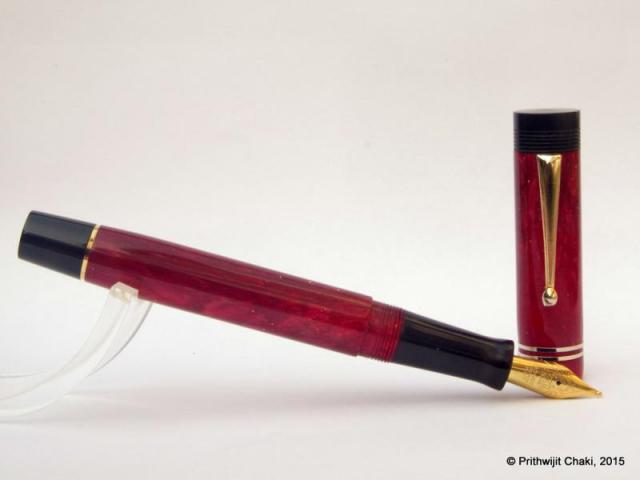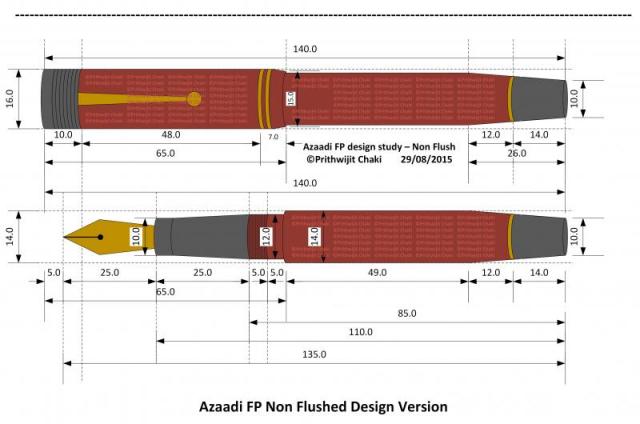Search the Community
Showing results for tags 'azaadi'.
-
ASA Azaadi in opal Creating a new ASA Azaadi in opal gave me a four-part tutorial in pen design. I commissioned the Azaadi after reading an account of a stunning similar pen in casein by Prithwijit Chaki, a prolific contributor to the Fountain Pen Network. Inspired by the fine white-on-ivory veins of the casein, I set about looking for a material that would simulate the elegance without the fragility. [/url] Capped, the Azaadi is about 1 centimeter longer than a Lamy Safari. Uncapped, it’s about the same length, and considerably thicker. Lesson No. 1 – Material Selection The Azaadi, as explained by Chaki, is based loosely on the Churchill design of the most recent version of the Conway Stewart company in the United Kingdom. When Conway Stewart closed shop in 2014, Vince Coates of The Turners Workshop in Newcastle purchased the remaining inventory of blanks and rods, and some of these materials are still available. There wasn’t a matching, veined white material, but opal offered a similar, classic quality. Coates shipped the opal to L. Subramaniam at ASA Pens in Chennai, who sometimes makes custom pens with material supplied by his clients. This opal doesn’t look like the gemstone. It includes translucent shades of amber, honey, and ivory, like the biscuit color of stained glass table lamps in the Mission, Arts and Crafts, or Tiffany styles. Whatever is underneath the acrylic opal material is visible, especially if what’s underneath is dark. The Azaadi design typically uses black acrylic for the section and finials. Because the opal material remains relatively thick near the finials, most of the black acrylic underneath is obscured. But at the section, where two sets of threads overlap (the cap to barrel and the barrel to section), the material is extremely thin. At this joint, the black section shows through the opal material. The opal material is translucent, but white teflon tape masks the black section under the barrel-to-cap threads. If I were making the pen again, I would probably select a medium-toned, opaque ivory or amber color for the finials and section. But my error also presented a solution – the white Teflon tape used by plumbers to seal pipe fittings. It’s designed to be an extremely thin, white, sealing dry lubricant. Wrapped in a single layer around the threads between section and barrel, it masks the black section underneath. The tape needs to be replaced with ink changes, like lithium grease in an eyedropper, but it’s not a particularly big deal. Lesson – think not just about material aesthetics, but about how the materials fit together. Lesson No. 2 – Ink Compatibility This pen uses a Jowo No. 6, 1.1 mm italic nib and a Schmidt K-5 cartridge-converter. I’ve used this nib in other pens, and never had an issue with ink lubrication. But this particular Jowo nib is choosy about the ink it prefers. The first ink I selected worked beautifully -- a green-olive-brown color mix created by FPN contributor Chrissy, resembling the wrapper of a “candela” cigar. It uses Noodler’s permanent Bad Blue Heron and three Diamine inks. But then I realized that specks from the permanent ink component could stain the interior of the translucent material and show through to the outside. So I swapped out the ink for a conservative Waterman brown. Too dry. I tried Diamine Saddle Brown, another conservative choice. Too dry. My fourth choice, Pilot Iroshizuku yama guri, works smoothly and beautifully. Lesson – nibs and materials sometimes require different inks. Pilot Iroshizuku yama guri ink flows smoothly in this Jowo 1.1 mm italic nib. Lesson No. 3 – Furniture The ASA Azaadi has been reviewed several times, including Chaki and Sanyal Soumitra. A regular refrain is that the furniture could be better, and they are right. Furniture is the jewelry of the pen, the first thing people notice, setting a tone for everything else. This furniture is adequate, but no match for the elegant workmanship of the rest of the pen. Lesson – clips, bands, and rings make a difference. ASA tolerances and workmanship outclass the metal furniture. Lesson No. 4 – Azaadi The Azaadi is an Indian pen derived loosely from a Conway Stewart design named after Winston Churchill. Chaki explains that the pen was named “Azaadi,” (आजादी in Hindi), meaning "independence, freedom, or liberty.” The name is partly cheeky repartee to Churchill, who strongly opposed Indian independence, and partly a reference to the pen’s launch date on August 15, Independence Day in India. Azaadi also signifies political, spiritual, and intellectual enlightenment, with various spellings in other Indian and Iranian languages. Beyond the dictionary, the concept of azaadi is rooted in the Indian struggle for independence and the role of Netaji (meaning “Respected Leader”) Subhas Chandra Bose between 1920 and 1945. Bose revamped the Indian National Army and opposed the British during World War II, creating an independent, nationalist legacy that ultimately led to a British decision to withdraw from India. Bose's clarion call -- Tum mujhe khoon do, mein tumhe azaadi doonga (Give me blood, and I promise you freedom) -- shows the importance of azaadi. Based on a British design with a British material, constructed in India, named Azaadi in response to Churchill -- the ASA Azaadi pen is a story about a complicated relationship between India and the UK. Lesson – a pen is a symbolic tool of intellectual enlightenment. Pens tell stories, but they can also be the story. In Conclusion – Taking Risks Creating a new custom pen involves risks. My risks were minimal, because the design already had been used in several other iterations. Some things in my version worked perfectly, including the elegance of the opal material, the balance, and the writing comfort of the section and the nib. Some things didn’t, including my first ink choices, the translucent barrel-to-section joint, and the furniture. In other custom pen designs, I’ve seen how some choices work and some don’t. Conclusion – regardless of whether risks result in wins or losses, they offer independence of choice, freedom to make mistakes, and opportunity to learn. Writing sample from another country's declaration of independence. This particular Jowo 1.1 mm italic nib is choosy about the ink it prefers, and permanent inks could stain the interior of the translucent material. Iroshizuku yama guri flows smoothly.
- 22 replies
-
Casein (from Latin caseus, "cheese") is a milk protein which we widely consume in various forms such as cheese and as a food additives. An interesting anecdote in the story of Caseins is that it was a popular ingredient for making some of the earliest plastics called Casein plastics. For a very brief period of time, casein was a popular material in fountain pen manufacturing. This was in early 1920's when it was the only plastic that could be coloured. With the advent of celluloid which was a superior type of plastic, casein quickly fell out of favour. Pens made of casein are quite rare and I have never seen an Indian pen made out of this material. So when Vince Coates (http://theturnersworkshop.co.uk) made available some casein material, a bunch of us quickly seized the opportunity to get some unique pens done. The material we received was supposedly the same used by Conway Stewart in their brief sojourn of using Casein and hence we naturally opted for getting a few Azaadis made with these imported blanks. Below are the pictures of the ASA Azaadi made of Casein and also a side by side picture with it's cousin made with normal celluloid acetate. We did not use any rings on this pen since the material was considered too soft to attempt the heat setting method of inserting rings. Also the surface was kept largely untreated (except applying emery paper) in order to retain and exhibit the natural characteristics and property of the material. Hope you guys liked the pictures. Should you8 guys wish to read my review of the ASA Azaadi, then please click here. Regards, Prithwijit
-
Introduction Often in life one learns to appreciate the value of something only after the object is long gone. In my case, something along the same lines happened for Conway Stewart pens. One fine evening in July of 2015 I chanced upon a store selling off the last few Conway Stewarts they had in stock and I was mesmerised by their beauty. One look at the price tag however quickly brought me back to my senses. Modern CS pens were never known to be on the value end of the price spectrum and the huge custom duties and other applicable taxes in India meant that they were well outside my grasp. I was however acutely aware that CS pens would soon not be available anywhere anymore and was desperate to get a piece of the pie. Once back home, I resorted to trawling the internet and found the source for last few CS blanks being made available from their liquidation sale by Vince Coates (www.theturnersworkshop.co.uk). With the help of fellow FPNer Kapil Apshankar (@springrainbow) I managed to source some materials in sufficient quantity to make a few pens. I did not bother receiving the material in hand and instead had those sent directly to Mr. Subramaniam of www.asapens.in with full faith that he would help me make something nice out of them. I also found out that CS essentially used Bock 250 nibs in their pens and grabbed a small collection of nib units as complete triple system from www.beaufortink.co.uk. We worked on a design that was original and yet paid homage to CS and especially their flagship model Churchill. Once the outline was worked out, we launched the pen in the “Fountain Pen Pals India” WhatsApp/Telegram group on August 15th where it was received with incredible enthusiasm. After some ups and downs, we stabilized at around 30 orders within the group. That’s quite an achievement considering the fact that at that point of time, the group has fewer number of members than 30. While everybody didn’t necessarily book one Azaadi, there were quite a few members who opted to get more than one. Since it was launched on 15th August which happens to be India’s Independence Day, it was only fitting to call the pen “Azaadi” which means “Independence” in Hindi. It was also a cheeky repartee to Churchill whose opinions about Indians and the notion of Indian Independence weren’t necessarily very appropriate. Design I knew that I wanted an original design which would not be a rip-off of any existing Conway Stewart model and yet should provide some kind of a homage to the brand. We all know that the concentric circles on the cap filial of Churchill gives it a distinctive crown like look and decided to incorporate a similar crown in black ebonite in the pen we designed as a homage element. Other than that, it is a solidly utilitarian design that combines the best of the breed in a number of areas. Size-wise, we designed it to be approximately the same size as a Lamy Safari and fitted it with the section design from ASA I-Can / I-Will in black ebonite which is a personal favourite for the comfort it offers. The end of the barrel is also made using black ebonite and the barrel end was also tapered a bit as another homage clue to the CS Churchill. The clip used was a special vintage ball clip made of brass which is quite unique in itself. Design wise it’s a classic with simple straight lines for the cap and with only a slight tapering of the barrel. The top of the cap and the bottom of the barrel are flat and polished. The body of the barrel and the cap are polished smooth and shiny. The concentric golden bands on the cap add a touch of flair. All in all the pen was designed to be regular sized, light and robust with the two ends having design cues that pay homage to CS. Final CAD drawing of the pen design that went into production Since we didn’t have CS blanks for all, the pen was launched with the option of using a broad set of acrylic materials. Unsurprisingly, the pearlescent acrylic blanks used in the ASA Rainbow turned out to be the most popular. We were pleasantly surprised how the shine of the acrylic blanks was nicely complemented by the muted colour of the ebonite components helping offset the monotony. The materials and colours complement each other and their interplay enriches the design whether posted or unposted. Size and Balance At 140mm capped, this is the perfect size for an EDC (Every Day Carry) pen. The shape of the pen and especially the section design is also meant to accentuate the feeling of comfort. But nothing beats the feeling in hand once you start writing with it and realise the comfortable. Needless to say, the pen is well balanced and provides comfortable writing for extended periods. Nib While I did get a set of different bock nibs, the quantity available wasn’t sufficient to satisfy 30 orders. Hence the pen was launched with two nib options excluding Bock. One could get a Schmidt (Model FH 452) nib in F/M/B or else go for a Jowo/WIN nib (Model 12-56) in EF/F/M/B/1.1/1.5 tip options. Since I already have a considerable collection of Jowo nibs, I opted to get the pen with a Schmidt nib with a broad tip in golden finish. From a design standpoint, the clip nib and bands complement each other quite nicely thanks to the golden colour. Filling Mechanism I am a stickler for pens that accept standard international cartridges and compatible convertors since in my opinion they the optimum combination of value, system longevity, convenience and widespread compatibility. It is therefore hardly a surprise that the ASA Azaadi supports the same and it comes with a Schmidt K5 convertor out of the box. Build Quality The Azaadi exudes the usual hallmark of quality from ASA pens. The fit and finish and the tolerances are fine for a handmade pen. The joints are seamless and only discernible due to colour variations. It is obvious that the pen has been made with care and a considerable amount of time has gone into polishing and buffing to ensure a very high quality of the finish. The only improvement area that I can think of are the bands used in the cap. It isn’t as if the bands aren’t fitted properly, but rather I wish ASA had access to better (read thicker) bands to go with this pen. Writing Experience Schmidt is a renowned maker of triple units and their systems have a large user base thanks to a number of brands that use them. Such widespread adoption wouldn’t have been possible if the nibs weren’t of top notch quality. It is little surprise then that I am very happy with how the pen writes. Being a broad tipped unit means that the nib appears extra smooth and glides over the paper laying down a nice wet line. This nib however isn’t soft or flexible and is quite rigid or nail-like. We have to accept that as a characteristic of the nib and be happy about the excellent writing experience that it provides. Price and Value The ASA Azaadi is poised to be one of the flagships within ASA’s line up and its price is currently perched as amongst the highest in the line. That however doesn’t mean much in cost terms since the entire ASA line is so affordable and the pens so wonderful. Personally to me the price reflects the effort that goes into making each pen and that no compromises were made in using components within the constraints of what’s available in Chennai. AT the end of the day, the pen represents great value at an affordable price point. Specifications Since I have the benefit of having access to the original CAD drawing, I will be quoting the specifications from that. Actual production pens are likely to have small piece to piece variances given the nature of making handmade pens. The measurements should suffice to give you a fair idea of the size of the instrument. Length (capped) – 140 mm Length (uncapped) – 135 mm Length (cap) – 65 mm Length (section) – 25 mm Maximum width – 16 mm Minimum width – 10 mm Maximum section width – 12 mm Minimum section width – 10.5 mm From top to Bottom - Jinhao 159, ASA Azaadi and Lamy Safari Conclusion It is not very often that one gets an opportunity to be involved in getting a fountain pen design. It is even rarer to get an opportunity to direct the design and see the pen getting launched as a regularly available product in the vendor’s catalogue. For that reason alone the Azaadi is very special to me. People who have got a chance to own this pen have been very positively impressed by it’s balance, comfort and writing experience. The pen has been designed from the ground up as an EDC (Every Day Carry) pen and in my opinion it fulfills that role in a fitting and stylist fashion. I have no hesitation in recommending this pen to others and I am sure you would enjoy it too.
- 27 replies
















